Did you know that 2023 was the hottest year on record, with global temperatures soaring to unprecedented levels1? This alarming trend is closely tied to the rising levels of greenhouse gases, largely driven by fossil fuel consumption. As industries expand, the demand for resources like water for cooling systems has also surged, creating a ripple effect on our planet1.
Understanding these changes is crucial. Recent studies highlight how energy consumption and industrial activities are reshaping our world. From record-high emissions to the strain on natural resources, the consequences are far-reaching1. This guide dives into the science behind these shifts and their practical implications, offering insights into how we can address these challenges.
Key Takeaways
- 2023 marked the hottest year on record due to rising greenhouse gas levels1.
- Fossil fuel consumption is a major driver of global warming1.
- Water usage for cooling systems has increased with industrial growth1.
- Understanding these changes is essential for addressing their effects.
- This guide explores the science and practical solutions to these challenges.
The Significance of Environmental Impact in Today’s World
Global temperatures and resource use are reshaping ecosystems at an alarming rate. These changes are not isolated; they affect every corner of the world, from forests to oceans. Understanding the scale of these issues is essential for addressing their effects.
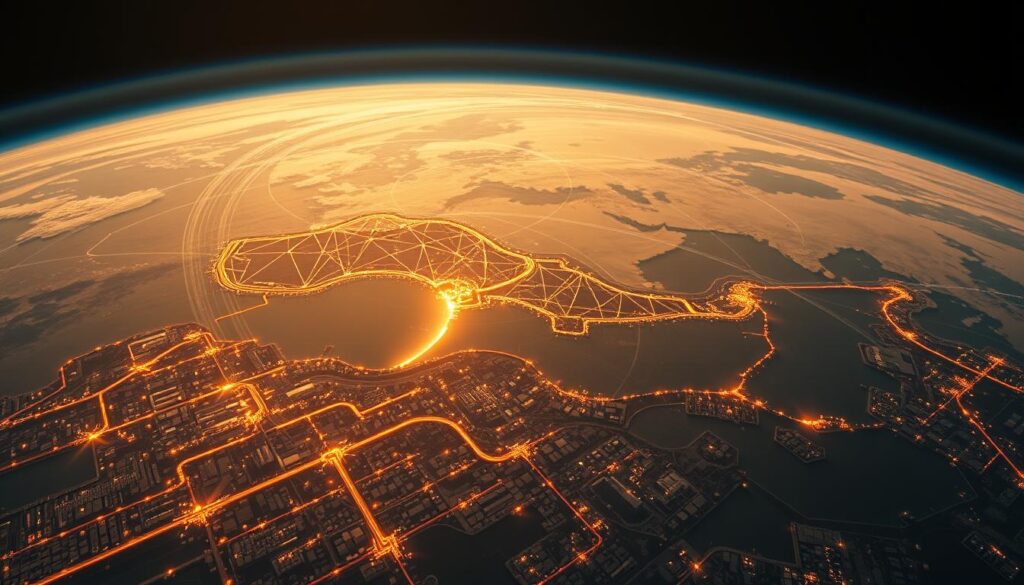
Overview and Key Definitions
An ecosystem refers to a community of living organisms interacting with their physical environment. A resource is any material or substance used to support life or economic activity. These definitions are critical for understanding the broader context of global challenges.
Human activities have led to significant changes in ecosystems. For example, atmospheric CO₂ levels have risen from 275 ppm in 1750 to 415 ppm in 20232. This increase has accelerated resource depletion and altered natural systems.
Why It Matters for Our Ecosystem
The world’s ecosystems are interconnected. Changes in one area can ripple across the globe. For instance, deforestation in the Amazon affects rainfall patterns as far away as the Midwest3.
Resource use is also a major concern. Fossil fuels account for over 80% of global energy consumption2. This reliance contributes to rising temperatures and biodiversity loss, which threaten both natural systems and human communities.
| Issue | Effect |
|---|---|
| Rising Temperatures | Increased heatwaves and extreme weather events4 |
| Resource Depletion | Strain on water and energy supplies3 |
| Biodiversity Loss | Disruption of ecosystems and food chains3 |
Addressing these challenges requires a global effort. By understanding the interrelation between resource use and degradation, we can develop strategies to protect our planet for future years.
Historical Context and the Evolution of Human Influence
Humanity’s journey over millions of years has shaped the world we live in today. From the earliest use of fire to the rise of modern industries, our actions have left a lasting mark on the planet. Understanding this history helps us learn from past mistakes and make better choices for the future.
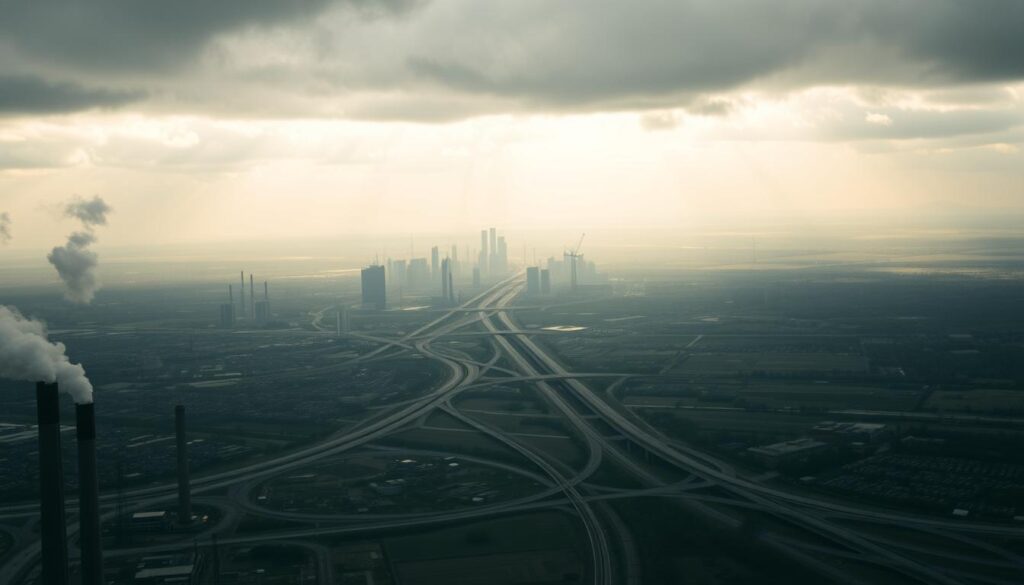
Timeline of Environmental Changes
Human interaction with the environment dates back to the earliest civilizations. Around 1.8 million years ago, Homo erectus began using fire, a milestone that changed survival strategies5. The Oldowan tool industry, dating back 2.6 million years, marked the start of technological advancements5.
Fast forward to the Industrial Revolution, and human influence accelerated. The demand for resources grew, leading to significant shifts in natural systems. For example, the Anthropocene epoch highlights how human activities have altered 75% of the Earth’s land surface5.
Lessons Learned from Past Actions
History teaches us valuable lessons. The collapse of ancient societies often resulted from resource mismanagement. For instance, deforestation and overuse of land led to the decline of civilizations like the Mayans6.
Today, we face similar challenges. Human population growth has increased sevenfold since the 18th century, putting immense pressure on resources7. Learning from the past can guide us in creating sustainable policies and practices.
By studying historical patterns, we can address current issues more effectively. This knowledge empowers us to take action and protect our planet for future generations.
Understanding Environmental Impact in Ecosystems
The delicate balance of ecosystems is being disrupted at an alarming rate. Human activities, such as deforestation and land conversion, are driving significant changes. These actions threaten biodiversity and the services ecosystems provide7.
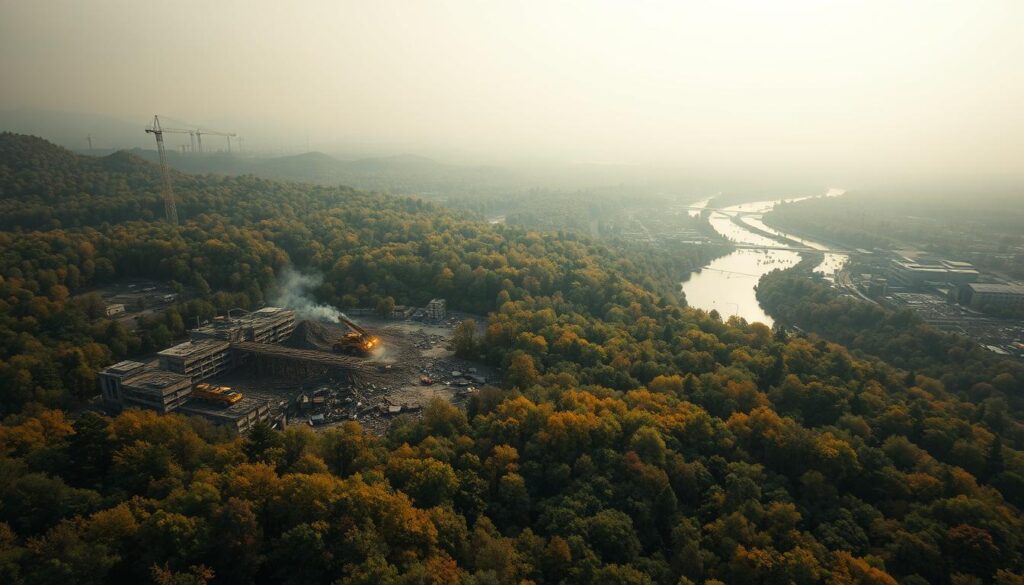
Biodiversity Loss and Habitat Disruption
Biodiversity loss is a critical issue. Over 83% of wild mammals and half of all plant species have disappeared due to human actions7. This decline affects the level of ecosystem resilience and their ability to support life.
Habitat disruption is a major driver. Deforestation in the Amazon, for example, has led to the fragmentation of habitats. This process reduces species diversity and disrupts ecological functions7.
Real-World Case Examples
Real-world examples highlight the severity of these issues. In the Amazon, deforestation has caused a 71% decline in shark and ray populations since 19707. This loss impacts the entire food chain.
Another example is the conversion of agricultural land. Approximately 40% of the world’s agricultural land is seriously degraded, leading to a high cost in terms of lost ecosystem services7.
| Issue | Consequence |
|---|---|
| Deforestation | Loss of biodiversity and habitat fragmentation7 |
| Land Conversion | Degradation of agricultural land7 |
| Overfishing | Decline in marine species populations7 |
Addressing these challenges requires a global effort. By understanding the process of ecosystem disruption, we can develop strategies to protect biodiversity and maintain ecological balance.
Climate Change as a Catalyst for Environmental Impact
The rapid rise in greenhouse gases has become a defining challenge of our time. These emissions, primarily from human activities, are accelerating global warming and reshaping our planet. Understanding their role is critical to addressing the consequences of climate change.

The Role of Greenhouse Gas Emissions
Greenhouse gases like carbon dioxide, methane, and nitrous oxide trap heat in the atmosphere. This process, known as the greenhouse effect, is the primary driver of global warming. Scientists have found that carbon dioxide levels have increased by over 50% since the pre-industrial era8.
Industrial activities, particularly the use of fossil fuels, are the largest contributors to these emissions. For example, burning coal, oil, and gas releases vast amounts of carbon dioxide into the air9. Methane, another potent greenhouse gas, is released during oil and gas extraction and from livestock farming.
The consequences of these emissions are severe. Rising temperatures lead to more frequent and intense heatwaves, storms, and wildfires. These events disrupt ecosystems, threaten food security, and displace communities8.
“The industrial use of fossil fuels has reshaped our atmosphere in profound ways, with consequences that will be felt for generations.”
- Carbon dioxide is the most significant contributor to global warming8.
- Methane and nitrous oxide are more potent but less abundant9.
- Industrial activities account for over 70% of global emissions8.
Addressing this issue requires collective action. Scientists emphasize the need to reduce emissions through cleaner energy sources and sustainable practices. Without immediate action, the consequences of climate change will only worsen9.
The Role of Water in Shaping Environmental Impact
Water scarcity is a growing concern, affecting both urban and industrial areas. Freshwater systems are under immense pressure due to rising demands. This issue is particularly evident in regions with high industrial activity and large populations10.
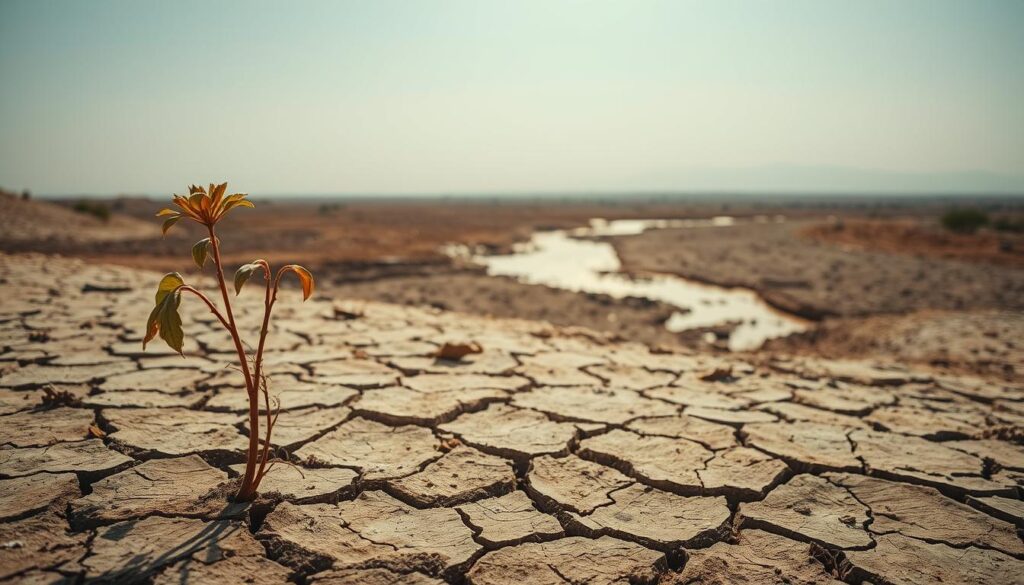
Water Scarcity and Resource Management
The result is a strain on freshwater systems, with many areas facing shortages. Urban centers and industries compete for limited resources, exacerbating the problem. For example, data centers require significant amounts of water for cooling, adding to the stress11.
Effective resource management is crucial. Strategies like recycling water and improving efficiency can help. However, the size of the problem requires global cooperation and innovative solutions12.
Cooling Demands and Data Center Challenges
Data centers are a major contributor to water consumption. For every kilowatt hour of energy used, two liters of water are needed for cooling11. This issue is growing as the number of data centers increases globally.
The result is a direct impact on local water supplies. Communities near these facilities often face shortages. Addressing this issue requires balancing technological growth with sustainable practices12.
| Issue | Result |
|---|---|
| Water Scarcity | Strain on freshwater systems10 |
| Cooling Demands | High water consumption in data centers11 |
| Resource Management | Need for global cooperation12 |
The size of the problem is often underestimated. Even small inefficiencies can add up to major challenges. By addressing these issues, we can ensure a sustainable future for water resources12.
Air Quality, Emissions, and Their Effect on Health
Air pollution remains one of the most pressing health challenges of our time. Millions of persons worldwide are affected by poor air quality, which stems from various sources. Understanding these sources and their effects is crucial for addressing this global issue.

Sources of Air Pollution
Vehicle emissions, industrial discharges, and biomass burning are major contributors to air pollution. In 2019, 99% of the world’s population lived in areas where WHO air quality guidelines were not met13. This widespread exposure highlights the urgent need for action.
Industrial activities, particularly those involving fossil fuels, release harmful pollutants into the air. For example, coal combustion is linked to higher mortality risks compared to other sources14. Addressing these sources is essential for improving air quality and protecting public health.
Health and Community Outcomes
Poor air quality has severe consequences for individual health and community well-being. In 2019, ambient air pollution caused 4.2 million premature deaths worldwide13. Respiratory and cardiovascular issues are among the most common health problems linked to polluted air.
Communities in low- and middle-income countries bear the greatest burden. For instance, 89% of premature deaths from air pollution occurred in these regions13. This disparity underscores the need for equitable solutions.
Air pollution also disrupts biological systems, leading to chronic diseases. Exposure to fine particulate matter (PM2.5) is associated with increased risks of heart disease, stroke, and lung cancer13. These health impacts affect not only individuals but also the broader community.
“Improving air quality can save lives and reduce the burden of disease worldwide.”
Policy challenges remain a significant barrier. Achieving WHO air quality guidelines could save approximately 300,000 deaths annually13. By prioritizing cleaner air, we can protect life and build healthier communities.
Deforestation and Land Use: Drivers of Environmental Impact
Forests are vanishing at an alarming rate, reshaping landscapes and ecosystems globally. From the Amazon to the boreal forests, industrial logging, agriculture, and urban development are driving this loss. These changes disrupt plant life and threaten the balance of natural systems15.
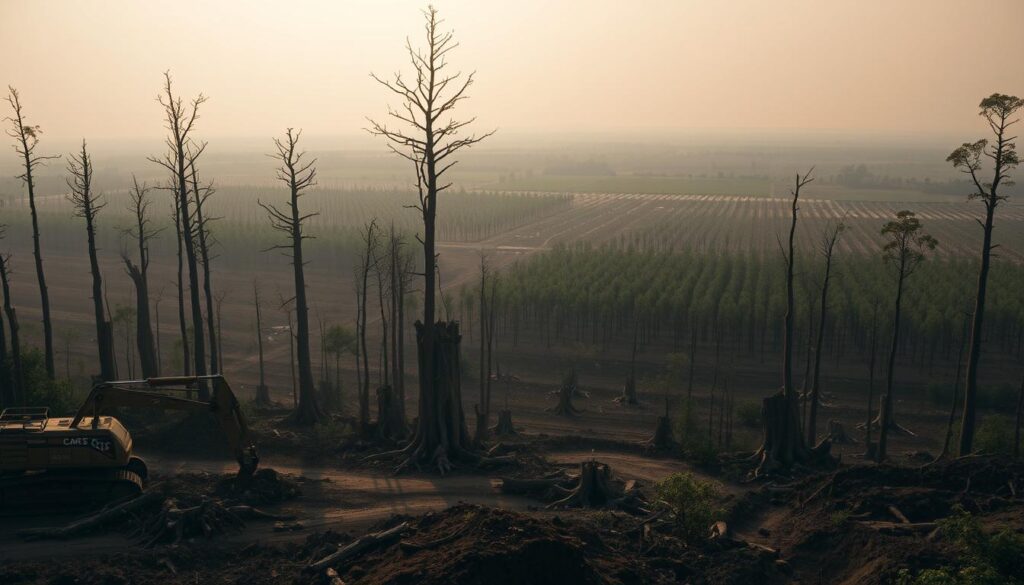
In the Brazilian Amazon, land used for soybean farming increased tenfold between 2000 and 201915. This expansion has fragmented habitats, reducing biodiversity and weakening the resilience of ecosystems. The loss of forests also diminishes natural resources, such as clean air and water, which are vital for life16.
Real-world examples highlight the severity of this issue. In Canada, wildfires burned over 18 million hectares of land in 2023 due to hot and dry weather15. Similarly, mining-related deforestation has surged, with one-third of global losses occurring in the last five years15. These events underscore the urgent need for action.
“Protecting plant diversity is crucial to maintaining ecosystem balance and a healthy environment.”
Efforts to address deforestation must focus on sustainable practices. For instance, the Forest Stewardship Council (FSC) certification promotes responsible wood harvesting15. Additionally, restoring ecosystems, such as planting riparian buffers, can enhance carbon sequestration and reduce flooding risks15.
By understanding the causes and effects of deforestation, we can develop strategies to protect our planet. Preserving forests is not just about saving trees; it’s about safeguarding the future of all living beings.
Soil Degradation and Agricultural Practices
Soil degradation is silently reshaping the foundation of global agriculture. Over 52% of the world’s farmland is currently affected by this issue, threatening food security and ecosystem health17. The loss of fertile soil has a cascading effect, disrupting agricultural productivity and natural systems.
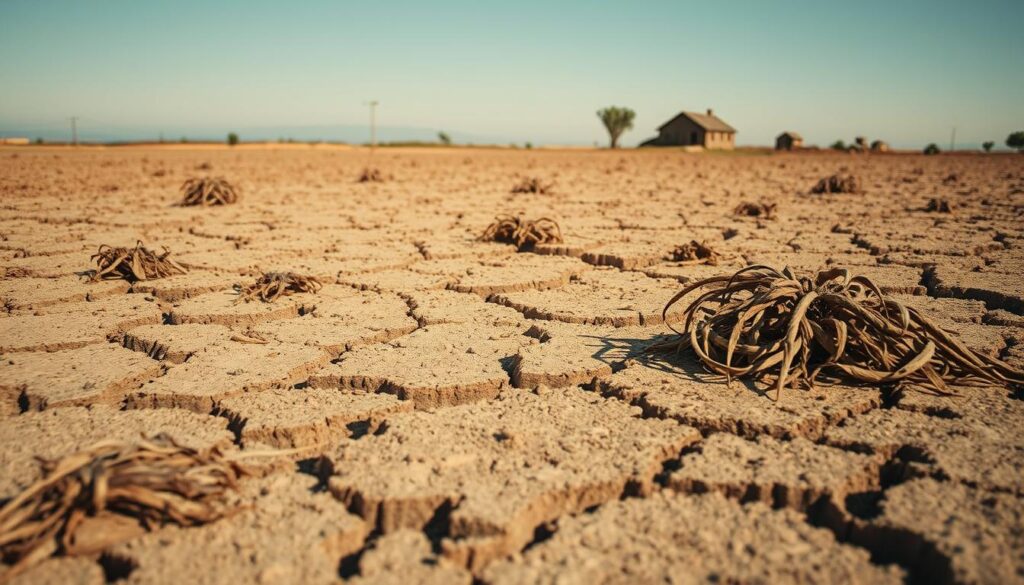
In the United States, approximately 50% of fields growing key crops like soybeans, wheat, and cotton are experiencing soil degradation17. Every five seconds, an area equivalent to a soccer field of soil is lost to erosion, highlighting the urgency of addressing this crisis17.
Impact on Food Security and Ecosystem Health
Soil degradation directly impacts food security. Crop yields have dropped by as much as 50% in severely affected areas17. This change in productivity threatens the livelihoods of farmers and the availability of food for millions of people.
The effect of poor soil management extends beyond agriculture. Over one-third of the world’s population lives in water-scarce regions, contributing to soil degradation18. This interplay between water scarcity and soil health underscores the need for sustainable practices.
- Soil erosion removes billions of tonnes of topsoil annually18.
- Industrial agriculture accounts for 22% of global greenhouse gas emissions18.
- Restoring degraded lands can enhance resilience against climate change17.
Efforts to combat soil degradation include innovative methods like crop rotation, cover cropping, and agroforestry. These practices not only improve soil health but also support biodiversity and ecosystem sustainability17.
“Healthy soil is the cornerstone of a sustainable future. Protecting it is essential for food security and ecosystem balance.”
By addressing soil degradation, we can ensure a stable food supply and preserve the health of our planet. The number of solutions available today offers hope for reversing this trend and building a more resilient agricultural system.
Economic Costs and Policy Debates Surrounding Environmental Impact
Economic policies play a pivotal role in shaping sustainable practices and community well-being. The costs of unsustainable practices are immense, affecting both economies and ecosystems. Addressing these challenges requires innovative solutions and robust policy measures.
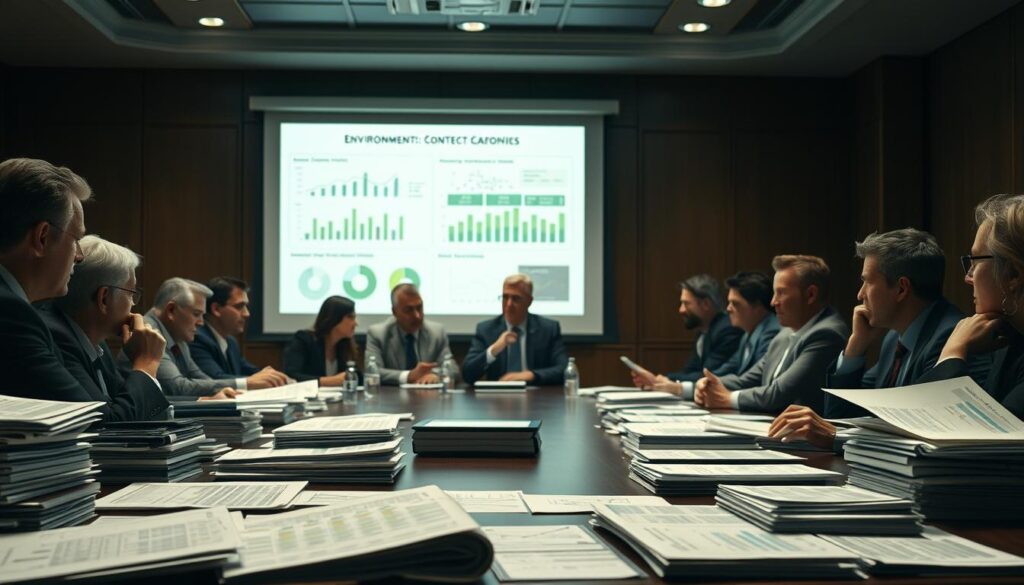
Market failures have contributed significantly to resource depletion and degradation. For example, the lack of pricing for natural resources often leads to overuse. Carbon taxes have emerged as a key tool to address these issues by internalizing the costs of emissions19.
Carbon Taxes and Market Failures
Carbon taxes aim to reduce emissions by making polluters pay for their impact. Studies show that these taxes can effectively lower pollution levels while encouraging cleaner technologies19. However, their success depends on proper implementation and enforcement.
Market failures, such as externalities and public goods, often lead to environmental degradation. For instance, industries may prioritize profits over preserving land, resulting in long-term harm. Addressing these failures requires governments to take part in creating balanced policies.
Innovative Policy Measures
Innovative policies are essential for protecting resources and ensuring sustainable growth. For example, cap-and-trade systems allow companies to buy and sell emission permits, creating economic incentives for reducing pollution19.
Real-world examples highlight the effectiveness of such measures. In regions with strict regulations, emissions have decreased significantly, benefiting both the environment and the community. These successes underscore the importance of governments taking part in long-term planning and market reform.
| Policy Measure | Impact |
|---|---|
| Carbon Taxes | Reduces emissions, encourages clean technology19 |
| Cap-and-Trade | Creates economic incentives for pollution reduction19 |
| Strict Regulations | Decreases emissions, protects resources |
“Effective policies can balance economic growth with resource preservation, ensuring a sustainable future for all.”
By addressing economic challenges and implementing innovative measures, we can protect land and support community well-being. Governments must play a central role in this effort, ensuring that policies are both effective and equitable.
Technological Advances and the Environmental Impact of AI
The rapid growth of AI technology is reshaping how we interact with the world. From healthcare to finance, AI’s potential is immense. However, its energy demands and cooling requirements pose significant challenges. Understanding these issues is essential for balancing innovation with sustainability.

Data Centers, Energy Use, and Cooling Challenges
Data centers are the backbone of AI systems, but they consume vast amounts of energy. Training popular AI models can produce around 626,000 pounds of carbon dioxide, equivalent to 300 round-trip flights between New York and San Francisco20. This carbon footprint is nearly five times the lifetime emissions of the average car20.
Cooling these systems is another major issue. Data centers require high quality cooling solutions to prevent overheating. For every kilowatt hour of energy used, two liters of water are needed for cooling21. This demand strains local water supplies and increases operational costs.
Sustainable Computing Practices
Addressing these challenges requires innovative solutions. Energy-efficient hardware and optimized algorithms can significantly reduce AI’s energy consumption20. For example, the National Science Foundation-led research initiative aims to cut the carbon footprint of computing by 45% within the next decade21.
Adopting sustainable practices is not just a statement of intent; it’s a necessity. By improving cooling efficiency and recycling water, data centers can reduce their environmental strain. These efforts ensure that AI remains a valuable tool without compromising our planet’s health.
“The AI industry must find ways to reduce its environmental impact to become valuable tools in combating climate change.”
As AI continues to evolve, so must our approach to its energy use. By prioritizing sustainability, we can harness AI’s potential while minimizing its footprint. This balance is crucial for a future where technology and nature coexist harmoniously.
Environmental Impact: The Science Behind Human Actions
Scientific research has uncovered critical links between human activities and changes in our planet’s systems. Through rigorous studies and data-driven models, we now understand how pollutants and chemical contaminants reshape ecosystems. These insights are essential for developing effective mitigation strategies.
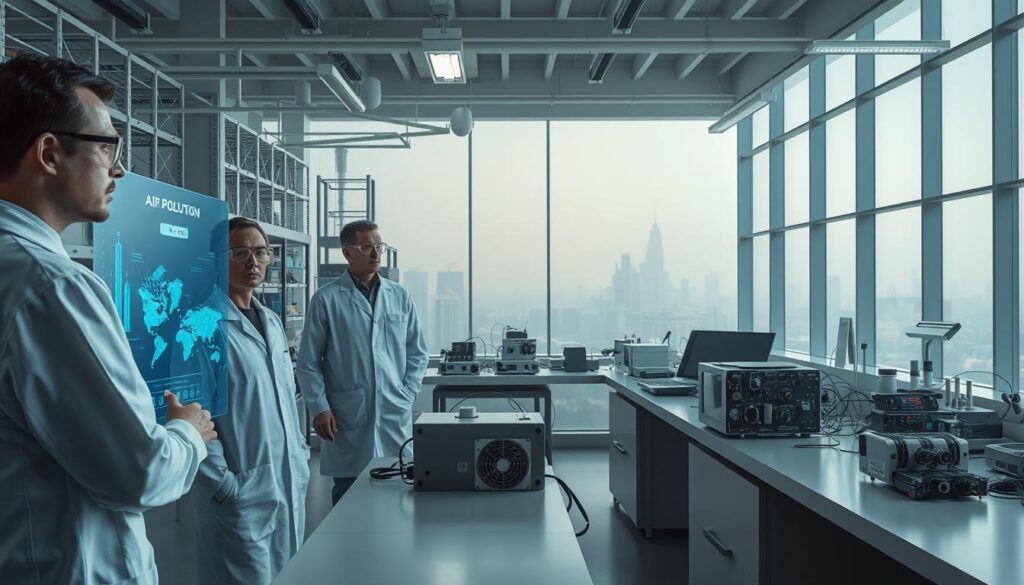
Key Scientific Studies and Data Insights
Human activities have driven the global warming trend observed since the mid-20th century22. The concentration of atmospheric carbon dioxide (CO₂) has increased by nearly 50% since 1750 due to these actions22. Methane, a significant greenhouse gas, is released from sources such as landfills, rice farming, and livestock digestion22.
Data-driven models play a crucial role in forecasting air quality and broader ecological shifts. For example, climate models that incorporate solar irradiance changes cannot reproduce the observed temperature trend over the past century without including a rise in greenhouse gases22.
Studies also highlight how pollutants alter environmental dynamics. Approximately 90% of the infrared heat radiated from Earth is absorbed by greenhouse gases and re-radiated back, slowing heat loss to space22. This process underscores the importance of reducing emissions to stabilize global temperatures.
“The increase of CO₂, methane, and nitrous oxide in the atmosphere over the industrial era is unequivocally the result of human activities.”
- Human activities are the primary driver of climate change, supported by tens of thousands of scientists23.
- CO₂ levels are currently higher than anything recorded in nearly a million years23.
- Research since the 1910s has ruled out natural factors as the main cause of climate change23.
Systematic assessments and models are vital for developing effective policies. By understanding the science behind these changes, we can create strategies to protect our planet for future generations.
Biodiversity Loss and Its Long-Term Effects
Urban expansion and industrial activities are accelerating the loss of species worldwide. The decline in biodiversity is reshaping ecosystems and human life in profound ways. From habitat destruction to pollution, the cumulative effects of city growth, waste, and emissions are driving this crisis.
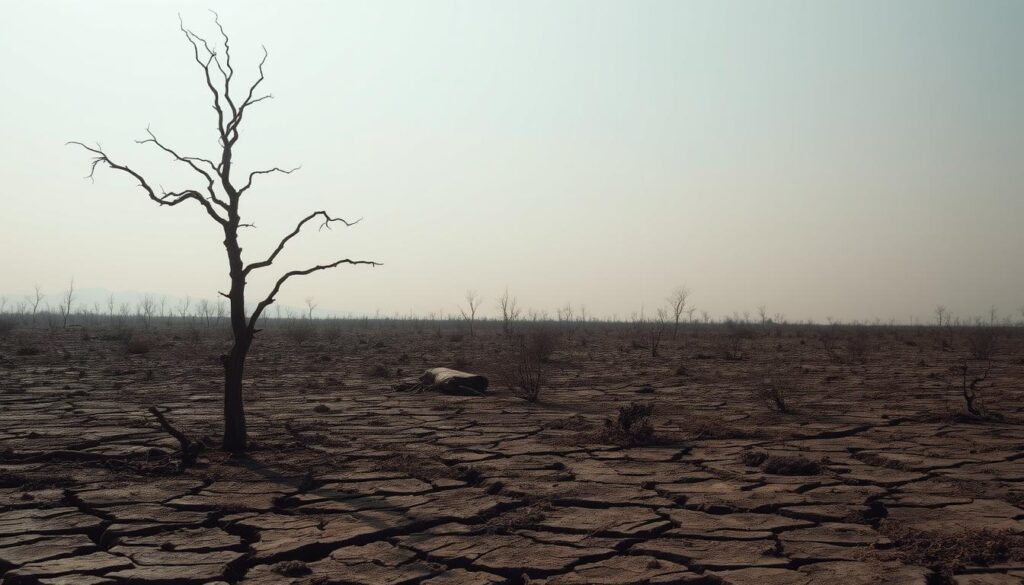
Butterfly populations have decreased by nearly 25% since the year 2000, highlighting the severity of this issue24. Similarly, approximately 75% of food crop varieties have become extinct since 1900 due to reliance on a limited number of high-producing varieties24. This loss of genetic diversity makes ecosystems more vulnerable to diseases and climate shifts.
Industrial waste and emissions are major contributors to habitat degradation. In 2019, the United Nations reported that out of an estimated eight million species on Earth, approximately one million are threatened with extinction25. The World Wildlife Fund (WWF) found a 69% decline in population size across 31,821 monitored species between 1970 and 201825.
“The loss of biodiversity is not just an ecological issue; it’s a threat to the survival of humanity.”
Urbanization is another critical factor. As city areas expand, natural habitats are fragmented, leading to species displacement. For example, 75% of the land surface is significantly altered due to human activities25. This transformation disrupts ecosystems and reduces their ability to provide essential services like clean air and water.
- Butterfly populations have declined by 25% since 200024.
- One million species are threatened with extinction25.
- 75% of land surfaces are altered by human activities25.
Efforts to protect biodiversity are underway, but more action is needed. As of January 2019, 7.5% of the world’s oceans and 14.9% of terrestrial land areas have been designated as protected24. The Aichi Biodiversity Targets aim to protect at least 17% of terrestrial and inland waters by 2020, with 164 countries developing plans to achieve these goals24.
Preserving biodiversity is essential for maintaining ecosystem resilience and human quality of life. By addressing the root causes of species loss, such as city expansion, industrial waste, and emissions, we can create a sustainable future for all.
Global Energy Demands and the Carbon Footprint
The world’s energy demands are reaching unprecedented levels, reshaping industries and economies globally. Fossil fuels remain the primary source, accounting for 75% of global greenhouse gas emissions26. This dependency has significantly increased the carbon footprint, which now represents 60% of humanity’s overall Ecological Footprint27.
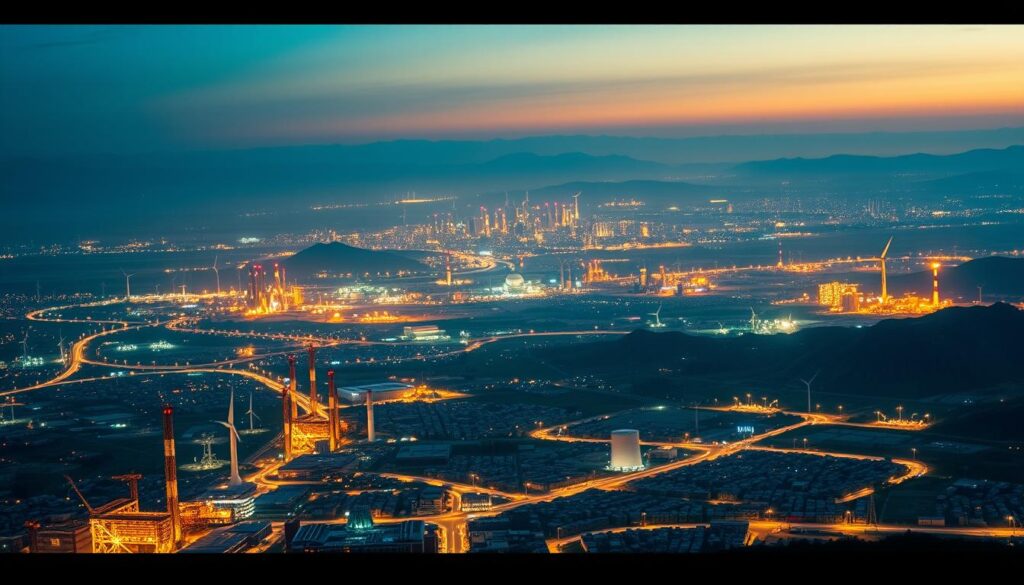
Renewable Energy Solutions and Alternatives
Transitioning to renewable energy is identified as a powerful way to reduce a country’s Ecological Footprint27. The IEA’s Net Zero Roadmap aims for the energy sector to reach net zero emissions by mid-century to limit global warming to 1.5 °C26. This shift requires innovative technologies and significant investments.
Leading companies are already paving the way for this transition. For example, COP28 commitments include a global pledge to triple renewable power capacity by 203026. These efforts are crucial for reducing the carbon emissions that drive climate change.
“The transition away from fossil fuels is not just an option; it’s a necessity for a sustainable future.”
However, the shift to renewables comes with challenges. Energy security risks, exacerbated by climate change, can lead to potential increases in energy prices26. Drought conditions, for instance, can impede the operation of thermo-electric and nuclear power plants, which require water for cooling26.
Despite these hurdles, the benefits of renewable energy are clear. By adopting sustainable practices, we can reduce the carbon footprint and ensure a healthier planet for future generations. The way forward lies in collaboration, innovation, and a commitment to change.
Societal and Community Challenges from Environmental Impact
Communities across the globe face growing challenges due to resource scarcity and policy gaps. These issues exacerbate social inequities, leaving vulnerable populations to bear the brunt of degraded living conditions. From poor air quality to inefficient waste management, the material and health costs are immense28.

In Europe, regions with lower socio-economic status experience higher exposure to pollutants like particulate matter and ground-level ozone28. These areas often lack access to high-quality food and green spaces, worsening overall health. For example, cities in southern and eastern Europe have less green space compared to their northern counterparts28.
An assessment of these conditions reveals significant policy shortcomings. The European Green Deal aims to address these disparities by mobilizing EUR 55 billion to support affected regions28. However, the success of such initiatives depends on effective implementation and community engagement.
Vulnerable groups, including the elderly and children, are particularly at risk. They face higher sensitivity to poor air quality, noise, and extreme temperatures28. These challenges highlight the need for targeted interventions to protect the most at-risk populations.
“Addressing societal challenges requires a holistic approach that integrates policy, community action, and sustainable practices.”
Efforts to mitigate these issues must focus on improving material conditions and reducing resource disparities. For instance, the Social Climate Fund provides financial support for vulnerable citizens and micro-enterprises, covering up to 37.5% of new national plans28.
| Challenge | Response |
|---|---|
| Resource Scarcity | Increased funding for sustainable practices28 |
| Poor Air Quality | Stricter emissions regulations28 |
| Health Inequities | Targeted support for vulnerable populations28 |
By addressing these challenges, communities can build resilience and improve quality of life. A comprehensive assessment of policy effectiveness and community needs is essential for creating lasting solutions.
Strategies for Mitigating Environmental Impact in the Future
Addressing global challenges requires innovative strategies that combine policy, technology, and community efforts. These approaches are essential for creating sustainable solutions that work around the world. By integrating diverse methods, we can tackle complex issues effectively.

Policy Reforms for a Sustainable Future
Policy reforms play a critical role in driving change. For example, the United Nations’ Sustainable Development Goals (SDGs) provide a roadmap for improving water quality, increasing renewable energy, and reducing waste29. Governments around the world are adopting these goals to create actionable plans.
One key initiative is Goal 13, which focuses on strengthening resilience to climate-related hazards. This includes investing in flood defenses and heat wave planning30. Such measures are vital for protecting communities and ecosystems.
Technological Innovations Driving Change
Technology is at the forefront of sustainable solutions. Advances in renewable energy, such as solar and wind power, are reducing reliance on fossil fuels. According to a study, tripling renewable energy capacity by 2030 is crucial for limiting global warming29.
Another example is the development of energy-efficient hardware. These innovations can significantly reduce the carbon footprint of data centers, which are essential for modern technology29.
Community Initiatives Making a Difference
Grassroots efforts are equally important. Local communities around the world are implementing projects to reduce waste and improve resource management. For instance, recycling programs and urban green spaces are enhancing quality of life29.
Community-led initiatives also focus on education and awareness. A study found that involving local populations in sustainability projects increases their effectiveness30.
“The success of sustainable strategies depends on the collaboration of governments, industries, and communities.”
- Policy reforms provide a framework for global action29.
- Technology innovations reduce emissions and improve efficiency29.
- Community initiatives foster local engagement and resilience30.
By combining these strategies, we can create a sustainable future. The dynamic interplay between policy, technology, and community efforts is key to driving meaningful change around the world.
Conclusion
The challenges we face today demand a collective effort to balance progress with preservation. Human operation, from industrial activities to policy decisions, plays a central role in driving change. Reliable sources and scientific studies have consistently highlighted the need for sustainable practices31.
Addressing these issues requires informed policy-making and proactive community action. Projects undergoing rigorous assessments are more likely to comply with regulations and minimize harm32. By leveraging data-driven insights, we can develop strategies that protect our planet while supporting growth.
Continued research and innovation are essential. From renewable energy to efficient resource management, solutions exist to reduce our footprint. Let’s remain engaged and committed to building a sustainable future for generations to come.
FAQ
What is the significance of environmental impact in today’s world?
How has human influence evolved over time?
What role does water play in environmental challenges?
How does air pollution affect health and communities?
What are the economic costs of environmental degradation?
How does technology, like AI, impact the environment?
What are the long-term effects of biodiversity loss?
How can renewable energy reduce global carbon footprints?
What strategies can mitigate future environmental challenges?
Source Links
- Environmental Impact Assessment and Mitigation – https://g3soilworks.com/2024/04/25/the-essential-guide-to-environmental-impact-assessment/
- What was the Industrial Revolution’s Environmental Impact? – https://greenly.earth/en-us/blog/ecology-news/what-was-the-industrial-revolutions-environmental-impact
- How Do Humans Affect the Environment? – https://onlinedegrees.kent.edu/blog/human-impact-on-the-environment
- Effects – NASA Science – https://science.nasa.gov/climate-change/effects/
- Introduction to Human Evolution – https://humanorigins.si.edu/education/introduction-human-evolution
- Climate change shaped human evolution, driving migration and cultural adaptation across ancient landscapes – https://www.news-medical.net/news/20240915/Climate-change-shaped-human-evolution-driving-migration-and-cultural-adaptation-across-ancient-landscapes.aspx
- Human impact on the environment – https://en.wikipedia.org/wiki/Human_impact_on_the_environment
- Hope as a catalyst for change in Climate Futures – https://harvardpublichealth.org/environmental-health/climate-solutions-need-hope-as-a-catalyst-ayana-johnson-says/
- Climate Change Stories – https://www.nature.org/en-us/what-we-do/our-priorities/tackle-climate-change/climate-change-stories/
- The Biggest Environmental Problems Of 2021 – https://earth.org/the-biggest-environmental-problems-of-our-lifetime/
- Explained: Generative AI’s environmental impact – https://news.mit.edu/2025/explained-generative-ai-environmental-impact-0117
- AI has an environmental problem. Here’s what the world can do about that. – https://www.unep.org/news-and-stories/story/ai-has-environmental-problem-heres-what-world-can-do-about
- Ambient (outdoor) air pollution – https://www.who.int/news-room/fact-sheets/detail/ambient-(outdoor)-air-quality-and-health
- Air Pollution and Your Health – https://www.niehs.nih.gov/health/topics/agents/air-pollution
- Deforestation and Forest Degradation: The Causes, Effects, and Solutions – https://www.nrdc.org/stories/deforestation-forest-degradation-causes-effects-solutions
- Deforestation and Forest Loss – https://ourworldindata.org/deforestation
- Soil degradation and its impact on your food supply — Helios AI – https://www.helios.sc/blog/soil-degradation-and-its-impact-on-your-food-supply
- Five reasons why soil health is declining worldwide – https://www.unep.org/news-and-stories/story/five-reasons-why-soil-health-declining-worldwide
- Exploring the emission reduction and economic impacts of environmental regulation from a dynamic endogenous perspective: evidence based on the PVAR and threshold models – Humanities and Social Sciences Communications – https://www.nature.com/articles/s41599-024-04230-8
- AI’s Environmental Impact: Growing Concerns Amidst Tech Advancements – https://uisobserver.com/news/2024/10/08/ais-environmental-impact-growing-concerns-amidst-tech-advancements/
- Can We Mitigate AI’s Environmental Impacts? – https://environment.yale.edu/news/article/can-we-mitigate-ais-environmental-impacts
- Causes – NASA Science – https://science.nasa.gov/climate-change/causes/
- 9 ways we know humans caused climate change – https://www.edf.org/climate/9-ways-we-know-humans-triggered-climate-change
- Biodiversity loss – Habitat Destruction, Species Extinction, Ecosystems | Britannica – https://www.britannica.com/science/biodiversity-loss/Ecological-effects
- What Are The Consequence Of Biodiversity Loss? | Earth.Org – https://earth.org/what-are-the-consequence-of-biodiversity-loss/
- Climate Change – Topics – IEA – https://www.iea.org/topics/climate-change
- Climate Change & the Carbon Footprint – Global Footprint Network – https://www.footprintnetwork.org/our-work/climate-change/
- Environmental inequalities – https://www.eea.europa.eu/en/topics/in-depth/environmental-inequalities
- How to achieve environmental sustainability – https://greenly.earth/en-us/blog/company-guide/how-to-achieve-environmental-sustainability
- Mitigation and Adaptation – NASA Science – https://science.nasa.gov/climate-change/adaptation-mitigation/
- Environmental impact assessment – https://en.wikipedia.org/wiki/Environmental_impact_assessment
- The Significant Role of Environmental Impact Assessment (EIA) – https://velosiaims.com/the-significant-role-of-environmental-impact-assessment-eia/
